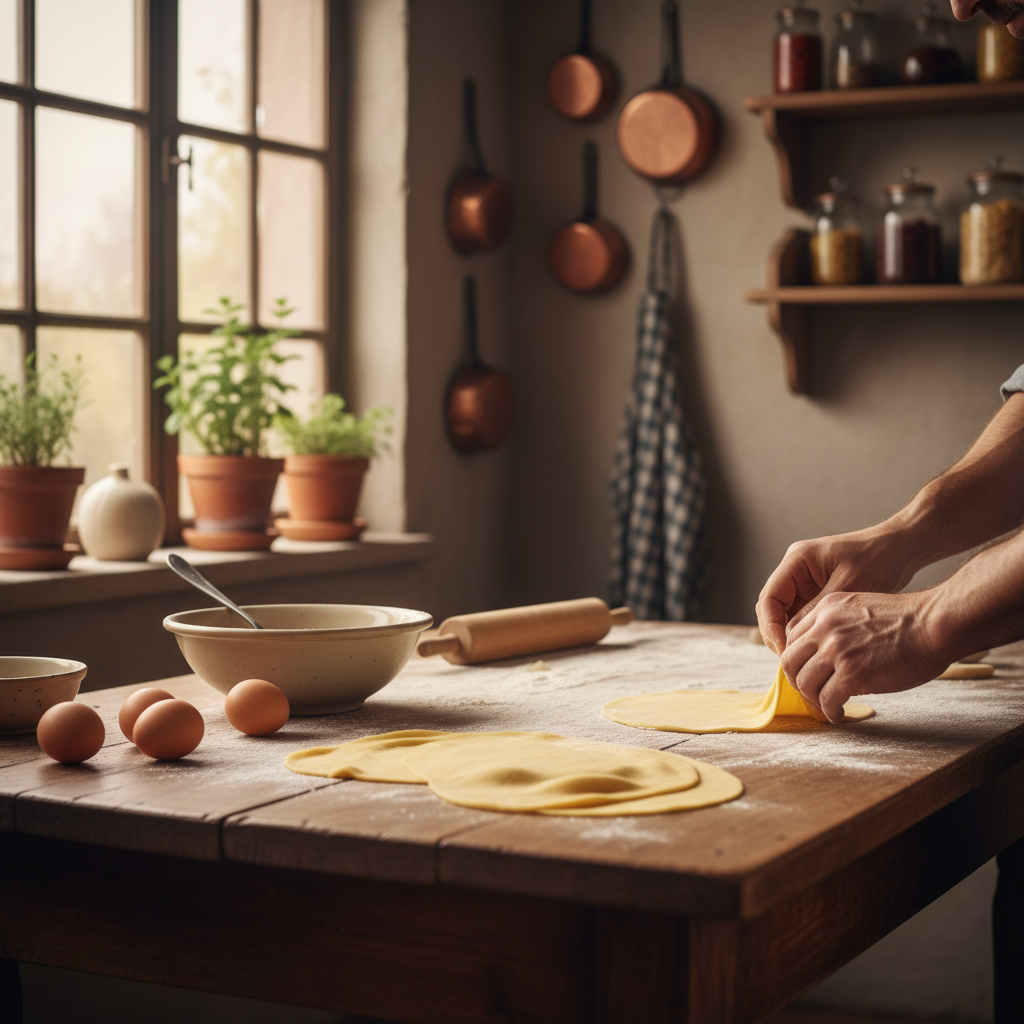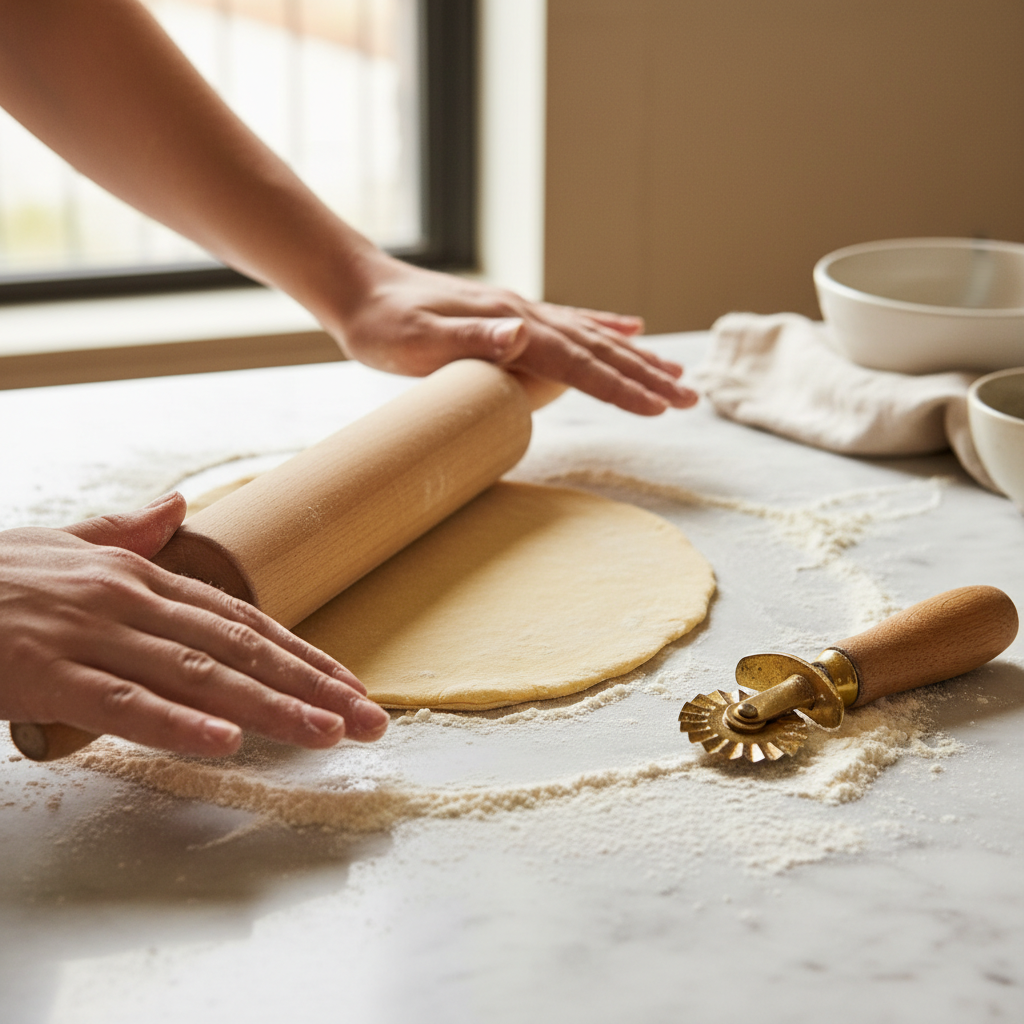
Table of Contents
Introduction
Imagine the rich aroma of freshly made pasta dough wafting through your kitchen, the silky texture of each delicate strand, and the satisfying taste that far surpasses any store-bought variety. Making homemade pasta from scratch may seem daunting at first, but with simple ingredients and clear techniques, you can create restaurant-quality dishes right at home. Whether you’re a seasoned cook or a curious beginner, learning to make pasta is a rewarding culinary adventure worth exploring.
Fresh pasta making is an age-old tradition that connects us to centuries of Italian culinary heritage. According to the National Pasta Association, more than 2 billion pounds of pasta are consumed annually in the United States alone, highlighting its widespread popularity. However, many people don’t realize how easy it is to craft fresh pasta from just a few basic ingredients—primarily flour, eggs, water, and a pinch of salt. The beauty of homemade pasta lies in the control it offers: you decide the texture, thickness, and shape, tailoring it to your family’s preferences and dietary needs. This personalized approach enhances both flavor and nutritional value compared to many commercially processed options.
Beyond taste, making pasta from scratch fosters creativity and mindfulness in the kitchen. The tactile process of kneading dough, the rhythm of rolling it thin, and shaping it into your favorite forms provide a sensory experience that nurtures both body and soul. For many home chefs, this hands-on method transforms meal preparation into a joyful ritual rather than a chore. It’s also an excellent way to involve family or friends in cooking, making it a shared activity that builds connection and lasting memories around the dinner table.
At the same time, mastering homemade pasta addresses common concerns like dietary restrictions or ingredient quality. Store-bought pasta can sometimes include preservatives or additives, whereas fresh pasta allows complete transparency regarding what goes into your food. For example, those with egg allergies can opt for eggless versions using water and semolina flour, while others might add herbs or vegetable purees to boost nutrition and color. If you’re new to this topic, you might want to start with understanding the best healthy food recipes that complement fresh pasta dishes and inspire wholesome cooking habits.
What You’ll Learn in This Guide
This comprehensive guide will walk you through the entire homemade pasta-making journey, from selecting ingredients to cooking perfect strands. Here’s what you’ll discover:
- Ingredients and Tools: Learn about the essential components for traditional pasta dough, including different flour types and when to use eggs or water, along with basic kitchen tools that simplify the process.
- Step-by-Step Techniques: Follow detailed instructions on mixing, kneading, resting, rolling, shaping, and cutting your pasta dough to achieve the ideal texture and form.
- Cooking and Troubleshooting: Discover cooking tips to boil fresh pasta properly and advice on solving common challenges like sticky dough or storage methods to keep your pasta fresh.
- Creative Variations: Explore ways to customize your pasta with added flavors, colors, and shapes, allowing your culinary imagination to shine and delivering unique dishes every time.
As we progress through this guide, you’ll gain confidence and skill to bring an authentic Italian touch into your kitchen. You’ll appreciate how versatile pasta making can be—adaptable for quick weeknight dinners or impressive meals for special occasions. Additionally, the knowledge shared here will empower you to experiment with flavors and recipes tailored to your personal taste preferences or dietary goals. The step-by-step approach ensures everyone, regardless of experience, can succeed.
By embracing homemade pasta preparation, you’re not only enhancing your cooking repertoire but also embracing a healthier lifestyle choice. The control over ingredients means you can avoid unnecessary additives and processed components often found in pre-packaged pasta. Moreover, the satisfaction of crafting food by hand fosters a deeper connection to what you eat and encourages mindful eating habits. If you ever face difficulties or want to elevate your skills further, consider seeking professional culinary advice or exploring specialized equipment to refine your technique.
Let this journey into fresh pasta making inspire you to savor more homemade meals, share joyous cooking moments with loved ones, and celebrate the art of Italian cuisine in your own home. Ready to roll up your sleeves and dive into the world of fresh pasta? Let’s begin this delicious adventure together and unlock the secrets to perfect homemade pasta that will delight your taste buds and nourish your soul.

Moving beyond the introductory exploration of homemade pasta, we now delve into the intricate details that transform simple ingredients into delightful fresh pasta. Making pasta at home is an art that combines tradition with personal creativity. The process requires understanding the key steps from dough preparation to cooking, allowing you to create meals that are not only delicious but also deeply satisfying. This detailed discussion will guide you through essential techniques and tips to elevate your pasta-making skills, making each step approachable and enjoyable for beginners and seasoned cooks alike.
Mastering the Dough Preparation and Shaping Process
The cornerstone of excellent homemade pasta lies in the quality and handling of the dough. Crafting the perfect dough starts with selecting the right ingredients, mainly flour and eggs or water, depending on your recipe preferences. The balance between these ingredients affects the texture and elasticity, critical in producing pasta that cooks evenly and feels authentic. Kneading is the next fundamental step, where patience and technique combine to develop gluten which gives pasta its characteristic chewiness. Following kneading, allowing the dough to rest is vital to relax the gluten strands, making the dough easier to roll and shape. These steps, if executed thoughtfully, enhance the overall pasta texture and flavor, ultimately impacting the eating experience.
Shaping the dough presents creative opportunities and can be done by hand or with a pasta machine. Rolling evenly ensures consistent thickness, which is crucial for cooking pasta uniformly. Various shapes—be it fettuccine, tagliatelle, or ravioli—offer different culinary adventures. Each form has specific cutting and handling techniques that determine how well the sauce clings and how the pasta cooks. Understanding these techniques empowers you to customize your pasta dishes while preserving the traditional qualities that make fresh pasta so appealing. For deeper insights into dough handling, exploring techniques that enhance texture can enrich your pasta-making journey.
Key Aspects of Dough Preparation and Shaping
Several crucial factors influence the success of your homemade pasta dough and its final form. Understanding these points helps in troubleshooting and perfecting your technique:
- Ingredient Proportions: Using the correct ratio of flour to eggs or water is essential. For example, 00 flour blended with eggs creates a smooth and elastic dough, ideal for most traditional pasta types. Slight adjustments can accommodate regional variations or personal texture preferences.
- Kneading Techniques: Proper kneading ensures gluten development which impacts elasticity and firmness. Knead until the dough is smooth and springy, usually about 10 minutes by hand. Over-kneading can toughen the dough, so timing is key.
- Resting the Dough: Resting for at least 30 minutes allows the dough to hydrate fully and gluten to relax, making rolling easier. Cover the dough to prevent drying out and ensure even texture throughout.
- Rolling and Cutting: Rolling the dough thinly and evenly is vital for cooking quality. Techniques vary from hand rolling with a pin to using a pasta machine, each offering control over thickness. Cutting shapes like fettuccine or ravioli require either a sharp knife or specialized tools to ensure clean edges and proper cooking.
Tips and Techniques for Cooking and Perfecting Homemade Pasta
Once your pasta is shaped, cooking it properly is the next crucial step towards a perfect dish. Fresh pasta cooks much faster than dried varieties, demanding careful timing and technique to reach the ideal texture known as al dente. Boiling pasta in plenty of salted water ensures flavor and prevents sticking, while timing the cooking precisely prevents overcooking, which can lead to a mushy outcome. Beyond cooking, knowing how to handle and store fresh pasta properly enhances your overall experience, especially when making pasta in batches or preparing dishes ahead of time.
Storage considerations include techniques for drying or freezing pasta to maintain its quality. Proper storage extends the usability of homemade pasta without sacrificing texture or flavor. Understanding common challenges — such as sticky dough or bundled noodles sticking together during cooking — and how to resolve them will make your pasta-making experience smoother and more enjoyable. These practical tips complement the cooking process and empower you to produce consistently excellent pasta dishes from your kitchen.
Important Considerations for Cooking and Storage
Keeping key factors in mind can help you master the final stages of pasta preparation, contributing to delicious results every time:
- Cooking Timing: Fresh pasta typically cooks within 2-4 minutes. Testing the pasta by tasting often is the best way to ensure it is perfectly al dente, firm yet tender.
- Boiling Water and Salt: Using ample boiling water with sufficient salt enhances flavor and prevents pasta from sticking together. Stir occasionally and avoid overcrowding the pot.
- Preventing Stickiness: Dusting fresh pasta with flour before cooking or tossing in a light drizzle of olive oil helps keep strands separate. After cooking, promptly draining and incorporating sauce prevents clumping.
- Storage Methods: Fresh pasta can be stored in the refrigerator for up to two days when wrapped tightly. For longer storage, freezing pasta on trays before transferring to airtight containers preserves freshness for months while preventing clumps.

Conclusion
Making homemade pasta is more than just a cooking task—it’s a rewarding culinary journey that connects you deeply to Italian tradition while unleashing your creativity in the kitchen. As we’ve explored, the foundation of great pasta lies in choosing the right ingredients, with flour types like semolina or 00 flour setting the stage for perfect texture and bite. Whether you opt for eggs or water as your liquid, balancing these components carefully is essential to crafting a dough that is flexible, smooth, and easy to work with. This attention to detail at the start lays the groundwork for every successful pasta batch.
The technique behind pasta making is equally crucial. Kneading builds the dough’s gluten structure, giving it strength and elasticity, while the resting period relaxes the gluten, allowing the dough to roll out thinly without tearing. Rolling and cutting techniques then transform the dough into a variety of shapes—from delicate fettuccine to hearty pappardelle or stuffed ravioli—each suited to different sauces and occasions. Cooking fresh pasta properly, with boiling water seasoned generously with salt, ensures a tender al dente bite that outshines store-bought options. We’ve also highlighted common challenges like sticky dough or pasta clumping together, and simple fixes such as dusting with flour or using olive oil to keep strands separate.
Storing your homemade pasta correctly can extend its shelf life and maintain its quality. Refrigeration is ideal for short-term use, while freezing pasta flat in sealed containers enables you to enjoy your creations later without sacrificing texture or flavor. Beyond technique, making pasta by hand cultivates a sensory experience—the feel of the dough, the aroma as it cooks, and the sight of fresh strands taking shape. This hands-on approach turns cooking into an artful ritual and an opportunity to share meaningful moments with loved ones.
As you gain confidence and experiment with different shapes, flavors, and colors—from spinach-infused dough to smoky seasonings—you unlock new dimensions of homemade pasta that celebrate personal taste and tradition simultaneously. The art of pasta making enriches mealtime, transforming simple pantry staples into dishes filled with warmth and satisfaction. Every fold, roll, and cut brings you closer to mastering a timeless craft that elevates your home cooking.
Ready to take the next step? Gather your ingredients, dust off your rolling pin or pasta machine, and embrace the patience and joy that come with each stage. Whether for quick weekday meals or special gatherings, homemade pasta invites you to slow down, savor the process, and relish the delicious rewards. This culinary adventure is accessible to everyone willing to start—it only takes a willingness to experiment, make mistakes, and learn from them. The result is a meal that not only tastes incredible but tells a story of care, tradition, and creativity. Enjoy the journey of fresh pasta making and delight in the homemade flavors that will undoubtedly become a cherished kitchen staple.
Frequently Asked Questions
-
Can I make pasta without eggs?
- Yes, using water and flour alone, you can create eggless pasta that is still delicious and works well for many recipes.
-
What type of flour is best for pasta?
- Semolina and 00 flour are ideal for their texture and bite, though all-purpose flour is a versatile option for beginners.
-
How do I prevent fresh pasta from sticking together?
- Lightly dusting pasta with flour before cooking and using plenty of boiling salted water helps keep strands separate.
-
Can I freeze homemade pasta?
- Absolutely, freezing pasta on a flat tray, then storing it in airtight containers preserves freshness for months.
-
How long does homemade pasta last?
- Fresh pasta can be refrigerated for 1-2 days; frozen pasta maintains quality for up to 2 months.
